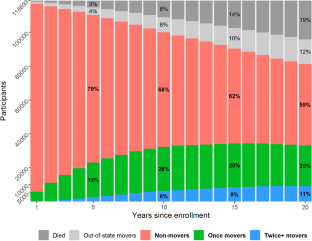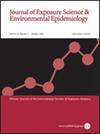构建居住历史,估算加州教师研究队列中的长期环境暴露。
IF 4.1
3区 医学
Q2 ENVIRONMENTAL SCIENCES
Journal of Exposure Science and Environmental Epidemiology
Pub Date : 2024-03-06
DOI:10.1038/s41370-023-00631-0
引用次数: 0
摘要
使用地理空间数据进行的环境流行病学研究通常以参与者注册时的居住地估算暴露量,但暴露期间的流动性可能会导致分类错误。我们的目的是通过构建加州教师研究参与者的居住历史记录来缓解这一问题,并对其进行跟踪调查(1995-2018 年)。我们从美国邮政服务、LexisNexis、Experian 和加州癌症登记处收集了地址记录。我们根据地理坐标距离(≤250 米)和街道名称相似度确定了相同地址的记录。我们对地址进行了整合,优先考虑参与者在随访问卷中确认的地址,并利用与记录相关的日期(如首次出现日期)估算出在每个地址居住的时间。在 23 年的随访期间,约有一半的参与者搬家(48%,其中 14% 迁往州外)。我们观察到,年轻女性、西班牙裔/拉丁裔女性以及大都市和社会经济地位较低地区的女性流动性更大。在注册后 5 年、10 年和 20 年,仍符合分析条件的州内流动者的累计比例分别为 21%、32% 和 41%。利用入学 10 年后收集的自我报告信息,我们正确识别了 94% 的搬家者和 95% 的未搬家者是否搬离了入学地址。该数据集为估计该队列中不同流行病学研究的长期环境暴露奠定了基础。影响:我们为 "加州教师研究 "参与者建立的居住历史记录(1995-2018 年)有利于未来的环境流行病学研究。在暴露期间提供地址可以减少因居住地变化而导致的误分类,尤其是在评估长期暴露和慢性健康结果时。这可以减少流动性较强的亚组(包括年轻女性以及来自社会经济地位较低和城市地区的女性)中的不同错误分类。与自我报告的居住地信息相比,我们整合多种来源地址的方法显示出较高的准确性。本次分析所产生的居住地数据集为未来的研究提供了宝贵的工具,最终将加深我们对环境健康影响的理解。本文章由计算机程序翻译,如有差异,请以英文原文为准。


Construction of residential histories to estimate long-term environmental exposures in the California Teachers Study cohort
Environmental epidemiologic studies using geospatial data often estimate exposure at a participant’s residence upon enrollment, but mobility during the exposure period can lead to misclassification. We aimed to mitigate this issue by constructing residential histories for participants in the California Teachers Study through follow-up (1995–2018). Address records have been collected from the US Postal Service, LexisNexis, Experian, and California Cancer Registry. We identified records of the same address based on geo-coordinate distance (≤250 m) and street name similarity. We consolidated addresses, prioritizing those confirmed by participants during follow-up questionnaires, and estimating the duration lived at each address using dates associated with records (e.g., date-first-seen). During 23 years of follow-up, about half of participants moved (48%, including 14% out-of-state). We observed greater mobility among younger women, Hispanic/Latino women, and those in metropolitan and lower socioeconomic status areas. The cumulative proportion of in-state movers remaining eligible for analysis was 21%, 32%, and 41% at 5, 10, and 20 years post enrollment, respectively. Using self-reported information collected 10 years after enrollment, we correctly identified 94% of movers and 95% of non-movers as having moved or not moved from their enrollment address. This dataset provides a foundation for estimating long-term environmental exposures in diverse epidemiologic studies in this cohort.
求助全文
通过发布文献求助,成功后即可免费获取论文全文。
去求助
来源期刊
CiteScore
8.90
自引率
6.70%
发文量
93
审稿时长
3 months
期刊介绍:
Journal of Exposure Science and Environmental Epidemiology (JESEE) aims to be the premier and authoritative source of information on advances in exposure science for professionals in a wide range of environmental and public health disciplines.
JESEE publishes original peer-reviewed research presenting significant advances in exposure science and exposure analysis, including development and application of the latest technologies for measuring exposures, and innovative computational approaches for translating novel data streams to characterize and predict exposures. The types of papers published in the research section of JESEE are original research articles, translation studies, and correspondence. Reported results should further understanding of the relationship between environmental exposure and human health, describe evaluated novel exposure science tools, or demonstrate potential of exposure science to enable decisions and actions that promote and protect human health.

 求助内容:
求助内容: 应助结果提醒方式:
应助结果提醒方式:


